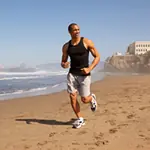More: Should You Race a Half Marathon Before a Marathon?
Continue with the plan you've been following if both races went well. If you struggled with the races, evaluate your training plan and marathon pace to see if any changes need to be made.
Non-goal races are also a great place to test your hydration and nutrition plan, and try out different clothing options for your marathon. It's better to find out something doesn't work for you during a target race rather than your marathon.
How to Dial in Nutrition and Hydration
Use your long runs to help you figure out when to drink, when to eat, and what to eat. If you find that certain things bother your stomach when running, you'll have time to try other things. There are many different kinds of bars, gels and gummy-type energy chews. You may also find that a creation you make works best for you. You'll also have plenty of time to try out different energy drinks, different concentrations of those energy drinks and even plain old water.
More: Best Long-Run Hydration Habits
Since you're increasing the number of miles you run, you'll need to make sure you're managing the number of calories you take in and burn. This is especially true if you are trying to shed a few pounds during your training. If necessary, keep track of calories consumed and calories burned to make sure you're eating enough, or to ensure that your deficit isn't too so high that it impacts your ability to train.
Drink enough water to stay hydrated all day. To make sure you're drinking enough on your runs, you may want to try out some different hydration equipment. Options include hand-held water bottles, hydration belts (a belt that holds small water bottles) and hydration backpacks (packs with a 1- to 3-liter water bladders in the backpack).
Gear for the Long Run
Now that you're going to be running farther than you ever have before, you may need different shoes. Head to a running specialty store and tell them your plan. They'll help you pick out the right shoes for you.
You may also find that your training clothes aren't quite right for longer distances. Your shorts, shirt or sports bra may chafe as you pile on the miles. You may have been able to get away with a regular cotton T-shirt for running shorter distances, but for running longer miles, you'll want a shirt that will help wick moisture away from your body to help keep you comfy.
More: 3 Gear Essentials for Newbie Runners
Socks are another important component to protect you from blisters and keep feet dry. There are many different types of socks out there with various thicknesses, layers, materials and height.
Compression gear—clothing that fits tightly on your body (a lot like cycling shorts) that is supposed to help your muscles recover by compressing the muscles to reduce fatigue and general soreness—is something else some runners swear by. Compression gear includes socks, tights, shorts, calf and arm sleeves.
Test any gear out during your long runs and practice races so that by the time marathon morning dawns, you know what works best for you.
So, what are you waiting for? Go find that first marathon!
More: 10 Best Marathons for First-Timers
 Sign up for your next marathon.
Sign up for your next marathon. - 2
- of
- 2
About the Author

Get ACTIVE on the Go


Couch to 5K®
The best way to get new runners off the couch and across the finish line of their first 5K.
Available for iOS | Android








Discuss This Article